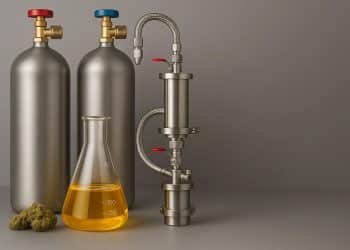John Monsour, Precision Extraction Solutions
It is critical to the safety and success of any cannabis processing operation to follow safety location classifications for manufacturing cannabis products, specifically related to Class I, Division 1 (C1D1) versus Class I, Division 2 (C1D2).
Why Safety Location Classifications?
Since fires and explosions are a significant safety concern in cannabis processing operations, how do you know which safety location classification best suits a potential cannabis operation? C1D1 or C1D2? Or both?
When any manufacturing or industrial production process requires hazardous materials (like the butane and other solvents used in cannabis processing), government regulations mandate the safety of those operations to protect workers and the general citizenry. These regulations apply in many industries, including those that require paint booths, industrial coating operations, and certain types of food manufacturing.
Some industries, like pharmaceuticals and oil/gas, operate at even higher regulatory standards than the C1D1 and C1D2 that apply to cannabis operations.
Why are Hazardous Locations Classified as C1D1 and C1D2?
There are many types of hazardous location classifications. These zones are considered areas where there may be fire or explosion hazards due to flammable, combustible, and ignitable materials in existence at all times under normal conditions or during an emergency. These areas require special consideration for equipment installation to ensure safety through design features that may include equipment like flame arrestors that can shut off gas flow if it detects a dangerous heat buildup.
The National Electrical Code (NEC) defines a National Fire Protection Association classification system for hazardous locations, which was updated in 2021. These zones identify areas that need safety features like specific types of wiring and other electrical components, fire suppression equipment, fire safety curtains, showers, first aid stations, and more. Article 500 identifies different classes in this Division with their specifications to meet any given requirements based on these classifications, such as height or location restrictions, etc.
Cannabis Extraction: C1D1 vs. C1D2
When it comes to classifying cannabis extraction facilities, the class and division systems deal with the observed building and fire codes of the areas that house flammable or potentially explosive gases (Class I) as opposed to dusts (Class II). Hydrocarbon compounds like butane and ethanol are frequently used in cannabis processing and can be volatile when exposed to heat and pressure. Determining whether your lab is C1D1 vs. C1D2 requires a bit more detail.
A manufacturing or processing facility will have extensive C1D1 safety features to prevent accidents. For instance, live gas monitoring is a requirement that ensures the gases released are removed from the space and that there are no sources for ignition like open flames and sparks from lighters nearby. The ventilation system must be capable of exhausting all gases at appropriate levels when necessary for safety. If something goes wrong inside this zone, it can happen in isolation without affecting anything or anyone else on site.
There’s more detail from Occupational Safety & Health Association (OSHA) of the U.S. Department Labor.
A Class I, Division 1 Location is one “in which ignitable concentrations of flammable gases or vapors may exist under normal operating conditions; or in which ignitable concentrations of such gases or vapors may frequently exist because of repair or maintenance operations or because of leakage; or in which breakdown or faulty operation of equipment or processes might release ignitable concentrations of flammable gases or vapors, and might also cause simultaneous failure of electric equipment.” (osha.gov)
A Class 1 Division 2 Location is a zone “in which volatile flammable liquids or flammable gases are handled, processed, or used, but in which the hazardous liquids, vapors, or gases will normally be confined within closed containers or closed systems from which they can escape only in case of accidental rupture or breakdown of such containers or systems, or in case of abnormal operation of equipment; or in which ignitable concentrations of gases or vapors are normally prevented by positive mechanical ventilation, and which might become hazardous through failure or abnormal operations of the ventilating equipment; or that is adjacent to a Class I, Division 1 location, and to which ignitable concentrations of gases or vapors might occasionally be communicated unless such communication is prevented by adequate positive-pressure ventilation from a source of clean air, and effective safeguards against ventilation failure are provided.” (osha.gov)
Is Cannabis Processing C1D1 or C1D2? That Depends.
OSHA has pushed states to create strict guidelines for cannabis extraction laboratories. However, each state interprets these standards differently because of the nuances in the national, state, and local building and fire codes. Some municipalities are hesitant about accepting Division 1 labeling as a standard safety measure when they could classify under Division 2, which has less stringent requirements.
The difference is in the assumptions regarding whether the environment will contain concentrated flammable or explosive gases or vapors. Division 1 assumes that some significant volume of solvent fumes will always be present. In contrast, Division 2 only does so if it’s operating under standard procedures and expects a small percentage to exist at any given time.
A Division 2 zone is a location where flammable or explosive gases would only be present if there were an accident or spill. Most people who work in closed-loop systems believe that they are well operated and accidents won’t happen. Unfortunately, safety incidents can happen fast.
Classifying a Cannabis Processing Business
So, how do you determine whether a cannabis processing operation is C1D1 or C1D2? It’s related to what products are being made, what equipment is being used, and how much solvent is being stored at any given time. While some might think the classification is specific to only the type of solvent being used, it is not. So, how is it determined? Here are a few examples of how processing operations can be classified as C1D1 and C1D2 zones.
Zones for Ethanol Extraction
Whether an ethanol extraction process requires a C1D1 or C2D2 classification zone depends on what product, process, and step you’re discussing. If a company’s hemp or cannabis extraction is conducted in a manner that is unpressurized, it would require a C1D2 room. If it is performed using a pressurized vessel, it would be considered a C1D1 classification.
Winterization using ethanol requires a C1D2 environment due to the vapors that can be generated during the process. Reaction vessels used to process crude oil can contain small amounts of solvent. If winterization is being done via a freezing unit, the freezer needs to be safety rated accordingly, commonly referred to as “explosion-proof.”
Typically, the process of distillation and use of distillation equipment doesn’t require a C1D1 or C1D2 zone, though all processes should occur in ventilated environments for safety.
Crystallization, a process used to make isolate, requires a C1D2 environment since the technician uses a solvent like pentane or ethanol.
Zones for Hydrocarbon Extraction
Hydrocarbon extraction is used primarily for cannabis, and both primary extraction and winterization require either a C1D1 or C1D2 environment. All hydrocarbon closed-loop systems that operate with pressurized vessels require a C1D1 environment.
Winterization after hydrocarbon extraction may require a C1D2 zone for reaction vessels, particularly if you have to winterize crude oils. You will also need to use one of the aforementioned explosion-proof freezers.
When removing residual solvents after primary extraction with a vacuum oven, a C1D2 environment isn’t required. You’ll simply need a well-ventilated area and the appropriate exhaust system. Distillation equipment used in post-processing doesn’t require a C1D1 or C1D2 rated environment, either.
Separating Cannabis Extraction Equipment for Safety
Following proper safety protocol during cannabis extraction processes requires that the equipment that needs a higher safety classification is placed into its own enclosed room. It’s typical to build at least two rooms if the operation is processing from extraction through the creation of distillate or isolate products—one that’s explosion-proof and one that’s a standard manufacturing space for processes like distillation, decarboxylation, vacuum ovens, and secure storage.
Check out these C1D1 pods created by Precision Extraction for more details on what’s available in the form of cannabis extraction laboratory buildings.
Creating a C1D1 or C1D2 Environment for a Cannabis Processing Operation
One of the most important things you can do when building a cannabis processing business is to bring in a consultant team very early in the process. Select a group with significant experience in the cannabis industry and in handling hazardous materials. Allow that team to advise you in the creation of the physical plant for the operation. Proper safety protocols and close attention to regulation are two critical factors that help keep your people safe, ensure you’re able to get the proper licensing and pass regulatory inspections, and help you avoid expenditures of time and money that will be incurred if you need to re-work your operation later. The right team will ensure you get the right equipment in the correct configuration the first time. You won’t regret it.












